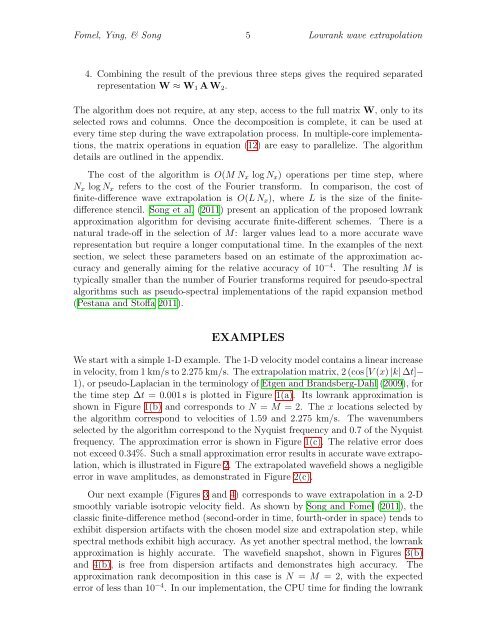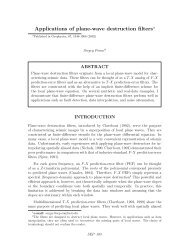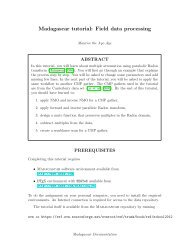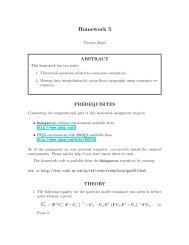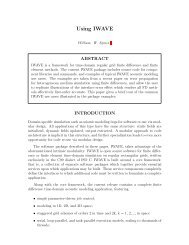Seismic wave extrapolation using lowrank symbol ... - Madagascar
Seismic wave extrapolation using lowrank symbol ... - Madagascar
Seismic wave extrapolation using lowrank symbol ... - Madagascar
Create successful ePaper yourself
Turn your PDF publications into a flip-book with our unique Google optimized e-Paper software.
Fomel, Ying, & Song 5 Lowrank <strong>wave</strong> <strong>extrapolation</strong><br />
4. Combining the result of the previous three steps gives the required separated<br />
representation W ≈ W 1 A W 2 .<br />
The algorithm does not require, at any step, access to the full matrix W, only to its<br />
selected rows and columns. Once the decomposition is complete, it can be used at<br />
every time step during the <strong>wave</strong> <strong>extrapolation</strong> process. In multiple-core implementations,<br />
the matrix operations in equation (12) are easy to parallelize. The algorithm<br />
details are outlined in the appendix.<br />
The cost of the algorithm is O(M N x log N x ) operations per time step, where<br />
N x log N x refers to the cost of the Fourier transform. In comparison, the cost of<br />
finite-difference <strong>wave</strong> <strong>extrapolation</strong> is O(L N x ), where L is the size of the finitedifference<br />
stencil. Song et al. (2011) present an application of the proposed <strong>lowrank</strong><br />
approximation algorithm for devising accurate finite-different schemes. There is a<br />
natural trade-off in the selection of M: larger values lead to a more accurate <strong>wave</strong><br />
representation but require a longer computational time. In the examples of the next<br />
section, we select these parameters based on an estimate of the approximation accuracy<br />
and generally aiming for the relative accuracy of 10 −4 . The resulting M is<br />
typically smaller than the number of Fourier transforms required for pseudo-spectral<br />
algorithms such as pseudo-spectral implementations of the rapid expansion method<br />
(Pestana and Stoffa 2011).<br />
EXAMPLES<br />
We start with a simple 1-D example. The 1-D velocity model contains a linear increase<br />
in velocity, from 1 km/s to 2.275 km/s. The <strong>extrapolation</strong> matrix, 2 (cos [V (x) |k| ∆t]−<br />
1), or pseudo-Laplacian in the terminology of Etgen and Brandsberg-Dahl (2009), for<br />
the time step ∆t = 0.001 s is plotted in Figure 1(a). Its <strong>lowrank</strong> approximation is<br />
shown in Figure 1(b) and corresponds to N = M = 2. The x locations selected by<br />
the algorithm correspond to velocities of 1.59 and 2.275 km/s. The <strong>wave</strong>numbers<br />
selected by the algorithm correspond to the Nyquist frequency and 0.7 of the Nyquist<br />
frequency. The approximation error is shown in Figure 1(c). The relative error does<br />
not exceed 0.34%. Such a small approximation error results in accurate <strong>wave</strong> <strong>extrapolation</strong>,<br />
which is illustrated in Figure 2. The extrapolated <strong>wave</strong>field shows a negligible<br />
error in <strong>wave</strong> amplitudes, as demonstrated in Figure 2(c).<br />
Our next example (Figures 3 and 4) corresponds to <strong>wave</strong> <strong>extrapolation</strong> in a 2-D<br />
smoothly variable isotropic velocity field. As shown by Song and Fomel (2011), the<br />
classic finite-difference method (second-order in time, fourth-order in space) tends to<br />
exhibit dispersion artifacts with the chosen model size and <strong>extrapolation</strong> step, while<br />
spectral methods exhibit high accuracy. As yet another spectral method, the <strong>lowrank</strong><br />
approximation is highly accurate. The <strong>wave</strong>field snapshot, shown in Figures 3(b)<br />
and 4(b), is free from dispersion artifacts and demonstrates high accuracy. The<br />
approximation rank decomposition in this case is N = M = 2, with the expected<br />
error of less than 10 −4 . In our implementation, the CPU time for finding the <strong>lowrank</strong>


